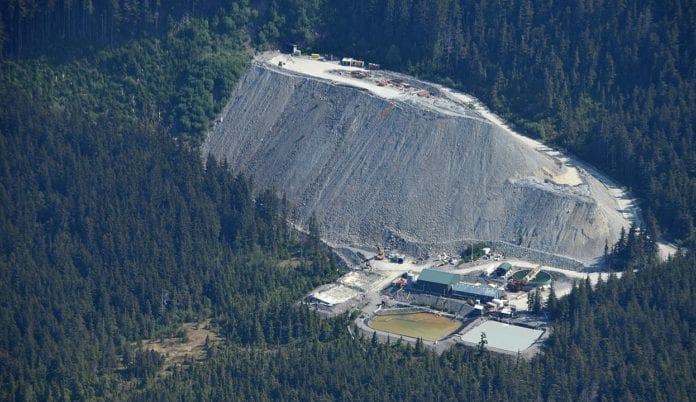
Owners of the Kensington Mine in Southeast Alaska will pay fines totaling $534,500 under a settlement reached with the U.S. Environmental Protection Agency over illegal discharges from the mine into waters that flow into the Inside Passage.
“Coeur Alaska’s Kensington mine generates and manages large volumes of both wastewater and stormwater containing pollutants that can degrade water quality and seriously harm aquatic life,” said Ed Kowalski, director of the Enforcement and Compliance Assurance Division at EPA Region 10 in Seattle.
The settlement announced on Aug. 8 cites numerous alleged violations documented in a facility-wide inspection conducted jointly by the EPA’s National Environmental Inspection Center and Alaska Department of Environmental Conservation enforcement officials in 2015.
The acid rock drainage flowed from Lower Slate Lake into Berners Bay in the Inside Passage, a water route between the Gulf of Alaska and Puget Sound that is popular with cruise ships.
EPA officials noted that mine water discharges not properly controlled and treated can harm water quality and aquatic life. By introducing high concentrations of toxic metals or increasing sediment turbidity fish can be harmed and eggs can be smothered in stream bottom gravels, EPA officials said. By introducing high concentrations of toxic metals or increasing sediment turbidity, fish can be harmed, and eggs can be smothered in stream bottom gravels, and high velocity discharge water can also erode stream banks and cause riverbank failure, the federal agency said.
How much this discharge of acid rock drainage might impact salmon habitat is hard to say, said Guy Archibald, staff scientist with the Southeast Alaska Conservation Council, “but it is at least an additional stressor on salmon. As ocean conditions become adverse, the freshwater habitat takes on additional importance as a refuge and for its contribution to genetic diversity.
“What is telling and most disturbing is that Kensington’s annual meeting with state and federal agencies was just held on June 12 in Juneau. None of these violations or impending actions by EPA were revealed or discussed. I am guessing that more than a few people in the room were aware. I have also noticed that the state has not conducted a site visit for at least three years,” he said.
“If Alaska has primacy for wastewater permits, why is EPA the one that has to assure compliance and enforcement?” Archibald asked.
The settlement agreement, which received state support, resolves numerous violations observed during the inspection and subsequent records review, Kowalski said.
The violations include 200 wastewater discharge violations, unauthorized discharge of acid rock drainage into Lower Slate Lake, improper operation and maintenance of sampling equipment, multiple effluent sampling violations and failure to develop a complete stormwater pollution prevention plan. Other violations include failure for over a year to repair a secondary containment structure that holds a majority of the facility’s fuel, failure to conduct required monitoring, assessments, inspections and trainings; failure to use proper sample handling and analysis procedures, and failure to report releases of nitrate compounds annually from 2013 through 2017.
As part of the agreement Coeur Alaska also signed an administrative order on consent for the unauthorized discharges of acid rock drainage into Lower Slate Lake. The order ensured that acid rock drainage would be collected and treated before it is discharged into the lake. Effective on Aug. 1, the state modified Kensington’s individual permit to authorize the discharge of residual acid rock drainage into Lower Slate Lake.





